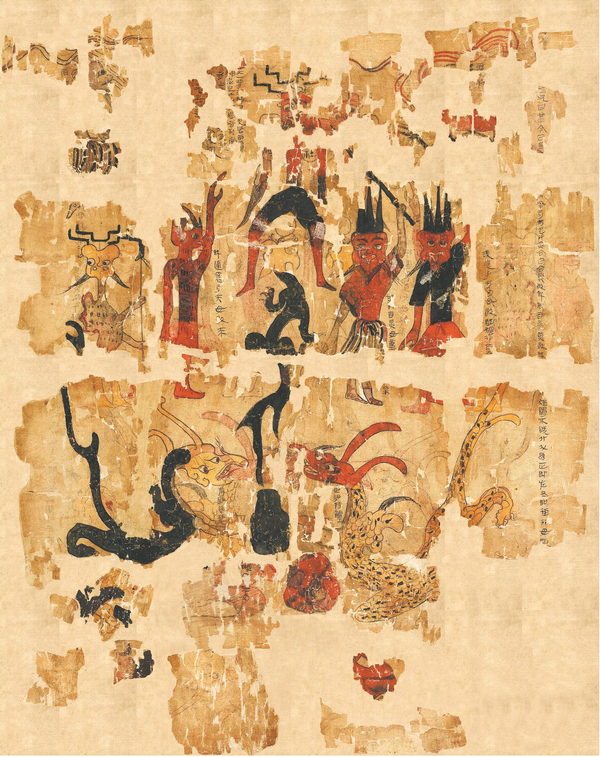
 0 Comment(s)
0 Comment(s) Print
Print E-mail China Daily, August 22, 2024
E-mail China Daily, August 22, 2024
The Mawangdui Han Tombs in Changsha, Hunan province, which have been recognized as one of the greatest archaeological findings of the 20th century, have offered not only massive pieces of artifacts but also presented a mini "library" of the Han Dynasty (206 BC-AD 220).

Silk painting excavated from the Mawangdui Han Tombs in Changsha, Hunan province. CHINA DAILY
This year marks the 50th anniversary of the excavation of the Mawangdui Han Tombs. On Sunday, after four years of efforts in making revisions and additions, an amended version of the Mawangdui Bamboo Slips and Silk Manuscripts was published, which is compiled by Hunan Museum and the Center for Research on Chinese Excavated Classics and Paleography at Fudan University in Shanghai, to celebrate the special occasion.
The two institutions committed decades to demystifying the characters and texts found on bamboo slips and silk manuscripts excavated from the Mawangdui tombs.
In June 2014, the first collection of Mawangdui bamboo slips and silk manuscripts was published. Compiled by the center and Hunan Museum, the seven-book collection reveals the complete raw materials of bamboo and silk manuscripts for the first time, offering a most comprehensive and accurate interpretation.
"There is no end in sight for the sorting and interpreting of the Mawangdui silk manuscripts. Although we have made many annotations, there is still much work unfinished. New silk pieces were published and a large number of scattered pieces have not been bound yet," says paleographer Qiu Xigui, chief editor of both collections and the leading professor at the center.
Liu Zhao, head of the center and organizer of the amendment and an editor of the collection, pointed out that the Mawangdui Han Tombs represent one of the most significant archaeological discoveries of the 20th century in China and the world.
"The thousands of artifacts excavated from Mawangdui depict a vivid, dimensional and stunning picture of the colorful Han Dynasty's social life. The bamboo and silk manuscripts discovered from the tombs are like a mini library, opening the door to learn more about the thoughts of the dynasty," says Liu.
According to a recent announcement from Hunan Museum, the Mawangdui Han Tombs were initially excavated between 1972 and 1974 and have produced 26,937 artifacts after decades of excavations.
The unearthed artifacts include the remains of Lady Xin Zhui, wife to an aristocrat and also called by some scholars as Lady Bi. Also unearthed were lacquerware, textiles and bamboo and silk manuscripts. The lacquerware unearthed from Mawangdui totals 1,017 pieces, 869 of which are intact. The textiles unearthed — mainly silk and hemp — total 24,490 pieces, including 212 intact pieces. The bamboo and silk manuscripts total 1,430 items, including silk books and paintings, wooden tablets and bamboo slips.
The center's research and the compiled collections focus on the bamboo and silk manuscripts, which tally over 130,000 characters. The texts include more than 50 classics with topics ranging from politics, military, philosophy, medicine and healthcare, astrology and more. Among the classics are I Ching (The Book of Changes) and Tao Te Ching, a philosophy book by Lao Tzu (571-470 BC).
"Our center's work is not only about recognizing the characters but also interpreting the texts and unlocking the historical, cultural and philosophical value in the content. … Some of the classics have been passed on till today. However, many have not been handed down, which will offer us new knowledge and are of extremely high academic value," says Liu.
The restoration process has not been easy. The silk pieces that have survived thousands of years are extremely fragile. Moreover, as most silk pieces were originally kept folded multiple times in a box with blank spaces and leaves in some layers, they closely clung together with printed scripts, making the main texts difficult to read after being immersed in water for ages.
The collection's first version has drawn extensive attention, discussion and feedback since its publication in 2014. A year later, over 60 scholars and experts gathered at a meeting to discuss the books' revisions. By May 2020, more than 500 papers and works were published based on the collection and raw materials, and the amendment was put on the schedule. Later in January 2022, Hunan Museum sorted over 230 new pictures of silk pieces for research.
During the four-year amendment, over half the center's professors and researchers have made contributions. While each specializes in one or several classics, the center also hailed the team's work in ensuring comprehensive and accurate output, according to the center.
The amended collection makes up about 1,000 pieces of revisions and complements. In addition, other major amendments include the rewriting of several classics, picture publication of the newly uncovered raw silk pieces, modification of over 60 silk pieces in the previous version, about 230 new bindings of silk pieces and color tuning of silk pieces to better display the texts and patterns.
"As Professor Qiu said, the research on Mawangdui sees no end — not only in the ancient writing field but also in diverse sectors such as artifacts, textiles, chemicals and technology. It is a long-term and sustainable subject," says Liu. "We believe the research on Mawangdui will flourish in the upcoming years and the Mawangdui Han Tomb culture will play a bigger role in showcasing traditional Chinese culture and telling China's story."
Go to Forum >>0 Comment(s)